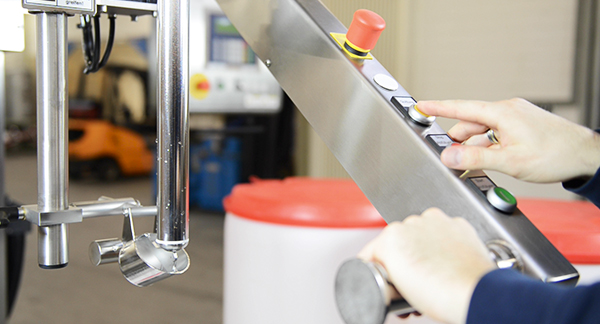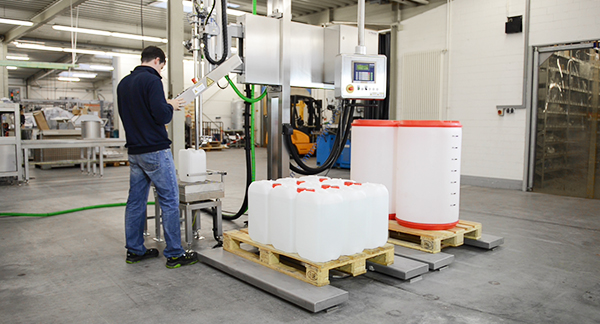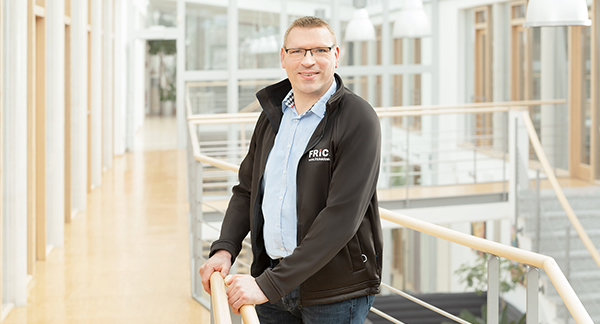The Federal Institute for Occupational Safety and Health (Bundesanstalt für Arbeitsschutz und Arbeitsmedizin) estimated lost production in the German through illness due to musculoskeletal and connective tissue problems at about 19.5 billion euros in 2019. Companies are therefore seeking ways to improve the ergonomics of the work process and protect the health of their employees. Fricke Abfülltechnik GmbH & Co. KG is making an important contribution: the FFS 21 filling station is suitable for low-viscosity liquids such as detergents and solvents, mineral oils and varnishes. It has been designed to allow filling on the palette, and the machine operator needs to use only one hand, making the process significantly more ergonomic. At the same time, the setting adjusts automatically after the programme number has been entered, ensuring avoidance of damage to the machine and the containers.
Media produced in the chemical sector, such as detergents and solvents, are often filled into large containers on scales in amounts weighing up to 35 kg per container. For further conveyance, they have to be lifted from the scales onto a palette. Not only does this process demand massive strength on the part of the operator, but repeated overstrain can also result in absence from work or even permanent disability.
Ergonomics are also often inadequately applied in machine operation. Conventional radial and coordinate filling systems have a fixed extension, incorporating a laterally-positioned filling head, which makes the equipment highly inflexible as regards handling. “To adjust to container that vary in size, such as intermediate bulk containers (IBCs), base height adjustment is needed,” explains Michael Krietemeier, Project Engineer at Fricke Abfülltechnik GmbH & Co. KG. “The current set-up compels the operator not only to use both hands to control the machine, but also to spend more time positioning the valve above a new container.”
Filling on the palette avoids manual transfer of the containers
This is where Fricke Abfülltechnik GmbH & Co. KG can help: the FFS 21 filling station, which is designed for the below-level procedure, is especially suitable for filling low-viscosity liquids into canisters with a capacity of 20 litres and more as well as for bunghole barrels und IBCs. “The FFS 21 allows canisters and drums to be filled on the palette,” clarifies Krietemeier. “Heavy containers therefore do not have to be lifted down from the scales by an operator and can immediately be further transported.”
With its roller bearings and swivel telescopic extension, to which the control arm is attached, the FFS 21 allows maximum flexibility during filling. This design allows both radial and linear pivoting movements, which overlap, significantly accelerating the positioning of the filling valve above the container and enabling several seconds to be saved every time. Furthermore, the control arm can be easily adjusted to the best height for the operator, thereby greatly reducing the stress on all the muscles and tendons in the back and shoulders. The filling process is controlled with one hand, taking the weight off the back in particular throughout the individual stages.
Positioning equipment prevents incorrect filling and machine damage
Fricke has also implemented a software for the FFS 21 that allows various filling programmes to be stored in the machine control, facilitating prior container adjustment. If, for example, up to three layers of containers on a palette are to be filled, the required data, such as target and tare weight, coarse- and fine-flow parameters, and container height, are recorded just once. “The container then simply has to be positioned on the palette and the programme number assigned to the respective filling procedure entered on the operating panel,” reports Krietemeier. “The valve is subsequently positioned automatically at the right height above the respective container. Other important components such as drip trays, fine-hold contact and upper stop also adjust to the selected programme.” This procedure not only prevents time-consuming incorrect filling and damage to machinery through faulty positioning of the valve, but also very significantly reduces changeover times.
During development, Fricke focused not only on good ergonomics, but also on achieving maximum compactness. For this reason, the equipment is modular in design and the customer can choose between different models, with one, two or three scales. “The space required varies from the minimum 1,500 x 3,000 mm to a maximum of 2,500 x 3,500 mm at a height of about 3,300 mm, depending on the model. Companies with little space can therefore also benefit from the good ergonomics and easy handling of various containers,” concludes Krietemeier.
_________________
Fricke Abfülltechnik GmbH & Co. KG was founded in 1870 in Rehme (North Rhine-Westphalia) and began by producing decimal scales that mainly helped dealers to weigh agricultural products correctly. The product portfolio was gradually expanded, Fricke then developing bagging scales for coal and briquettes, and soon afterwards the first dosing and filling systems, which are still used in numerous industries.
Today, the company offers fully and semi-automatic dosing and filling systems, together with the associated control software, for a variety of industries, including perfumes and aromas, coatings and paints, care und cleaning products, pharmaceuticals and cosmetics, foods, chemicals, adhesives, and construction chemicals and auxiliaries. Family-owned since it was founded, Fricke is currently led by a fifth-generation Managing Director and employs a staff of about 110 in Minden-Meissen – 16 of whom work in support and software development.
_________________
Here you can » download the image data «.



